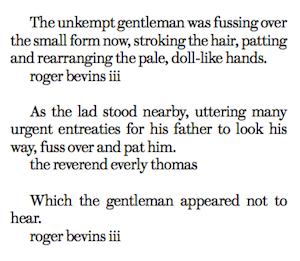In George Saunders’s best-known short story, “Pastoralia,” the narrator plays a caveman in a theme park. He and his fellow cave-dweller Janet must grunt their way through the day while visitors look in on their palaeolithic practices. Yet for the pair (who are not a couple) there’s no escape from the late 20th century. They must also fill in a “Daily Partner Performance Evaluation Form.” Janet is not pulling her weight and the narrator is reluctant to inform on her, as he is supposed to do. But he has a sick child, medical bills and maxed-out credit cards. Eventually he rats her out to save his job, applying himself more firmly to his employer’s mantra of “Thinking Positive/Staying Positive.”
An outlandish visitor park, staffed by life’s losers and sadistic middle managers, is a recurring setting for Saunders’s fiction. His protagonists are often forced to get someone weaker fired—and they can rarely afford not to comply with the bureaucratic tyranny. Fictional descriptions of the reality of modern work run the risk of being dull; but in his use of high-concept scenarios, Saunders manages to make you feel the truth of his insights almost better than any of his contemporaries.
Saunders is the most acclaimed American fiction writer who has (until now at the age of 58) never written a novel. When his story collection, entitled Pastoralia, was published in 2000, he had already been a regular contributor to the New Yorker for nearly a decade. His dystopian stories seemed like futuristic and whimsical successors to the surreal fiction of Donald Barthelme. It says as much about the way our reality has become more like one of his theme parks, as it does about his development as a writer, that his work has gained so much recognition in the last decade: a MacArthur “genius” grant and Guggenheim fellowship, both in 2006; the inaugural Folio Prize in 2014. His report from pro-Donald Trump rallies last summer now reads as a prescient and detailed piece of political analysis, rather than the satire for which some mistook it at the time.
In that New Yorker piece Saunders wrote: “American presidential campaigns are not about ideas; they are about the selection of a hero to embody the prevailing national ethos.” He then quoted Norman Mailer’s observation that heroes embody the fantasy lives of those who worship them, which leads him to ask: “What fantasy is Trump giving his supporters the liberty to discover? What secret have they been hiding from themselves?” Saunders has in the past castigated the mass media for being the equivalent of a man walking into a party with a megaphone and using “the volume and omnipresence of his narrating voice” to dominate others. This kind of influence throws up unworthy heroes, and led him to call the invasion of Iraq “a literary failure, by which I mean a failure of imagination.” The only way to resist the megaphone, he concludes, is to be “as precise, intelligent, and humane as possible.” In other words, to write and read fiction about losers, until heroes hold less appeal.
On first appearances, his debut novel may appear to break this rule. Lincoln in the Bardo takes as its subject one of the most celebrated figures in US history: Abraham Lincoln. But the focus is not on the familiar stirring rhetoric or triumphs in battle: this is a portrait of a public man at a very low ebb, the heroic president experiencing painful loss, all the while trying to cope with the most stressful job in America.
Saunders once wrote that every novel contains an “Apparent Narrative Rationale”—what the writer and reader have tacitly agreed the book is about. The pact Saunders makes with us is that Lincoln in the Bardo is “about” Lincoln’s reaction to the death of his second son, Willie, who died in February 1862 at the age of 11. But it would be wrong to call this a historical novel; in fact, I am not sure it is a novel at all. “Experimental” is an overused term, but Saunders genuinely seems to be piecing together a new form to fit his subject.
The spark for Saunders was the detail, reported in contemporary newspapers, that Lincoln went into the Georgetown crypt where his son was buried “on several occasions” after the funeral. The “bardo” of the title, although this is never explained, is a Buddhist term for the place where souls linger before they migrate to whatever’s next. (Saunders is a practising Buddhist.) The spirits in this zone don’t seem to know that they are dead, however, and children linger for mere minutes before moving on. To the horror of the flitting spirits, after Lincoln’s first visit, Willie stays in the hope that his father will visit again. And insofar as the novel has a plot, it concerns the efforts of three concerned souls to get Willie to move on from the bardo.
The story is told in two modes. In the first, the spirit trio, Willie, and a host of other trapped figures take turns to speak, either in long monologues, or in rapid dialogue. These sections are interspersed with writing in the second mode, reflective or historical interludes, describing, for instance, the party held in the White House while Willie was ill upstairs; or listing contemporary impressions of the 16th president.
Whether you will like this book will depend on how you feel about reading whole chapters in the vein of Lincoln’s first visit to the Georgetown cemetery:

Every ghost is named after it speaks; every historical observation is credited to a source. Roger Bevins III, for example, was troubled by his attraction to other men and committed suicide, only to change his mind after he had slit his wrists. The merging of fact and fiction (there are fictional “sources” among the real ones), combined with the dramatic monologues, amounts to something like a play mixed with a history sourcebook. It certainly avoids some of the tedium of much historical fiction, of which Gore Vidal’s Lincoln novel might be a prime example—or what André Breton, quoting Paul Valéry, identified as “The Marquise went out at five o’clock” problem.
Whatever genre Lincoln in the Bardo belongs to, it is unmistakably a work by George Saunders. The setting and themes seem to have been percolating in the writer’s mind for the best part of two decades. CivilWarLand in Bad Decline (1996), Saunders’s first short-story collection, contains two of his most dystopian settings. “CivilWarLand,” the visitor attraction in the title story, is set in an inaccurate recreation of the 1860s: “Whenever a potential big investor comes for the tour the first thing I do is take him out to the transplanted Erie Canal Lock. We’ve got a good 90 feet of actual Canal out there and a well-researched dioramic of a coolie campsite. Were our faces ever red when we found out it was actually the Irish who built the Canal.” The park is plagued by gangs of teenagers, but the narrator is also preoccupied with some 1860s-era ghosts: a family who once lived on the land where the park now stands, and who are doomed to re-enact a grizzly murder for ever. In the same collection is “Bounty,” set in a theme park where people who have been poisoned by an environmental disaster are slaves to those who were unaffected; in the aftermath of the event, the Thirteenth Amendment was repealed and slavery has returned to the US.
In Lincoln in the Bardo, the Thirteenth Amendment is three years away. We have very little direct access to the president’s mind, and it’s the death of his son that occupies his attention. The ghosts are the focus of the action. Like every Saunders protagonist, they have led unhappy and unsuccessful lives. Hans Vollman is a middle-aged printer who dies before having sex with his much younger wife and is left with an eternal erection in the afterlife. The Reverend Everly Thomas is the only spirit who knows he’s dead, and orchestrates what little action there is.
Saunders has explained that he began setting stories in theme parks to avoid the trap of writing poor imitations of Hemingway. Freed from naturalism his sentences, he claims, gained more “oomph”—“It was one of those artistic accidents where I thought I was just doing something to be pragmatic, and then when I did it I could see all the political ramifications.”
Another writer whose influence he has tried to escape is Ayn Rand. Atlas Shrugged grabbed his imagination as a teenager: “if you’re a crummy reader sometimes bad art can do magical things,” he has said. The effect of this “patron saint” eventually wore off and better writers took her place (Isaac Babel and Henry Green, among others), but it’s no exaggeration to say that Rand’s influence—and Saunders’s realisation of its political ramifications—can be found everywhere in his work.
"Ayn Rand's influence can be found everywhere in Saunders's work—but his parodies of her are much more fun than the real thing"His parodies of Rand are much more fun to read than the real thing. A father in “Pastoralia,” writes to his son: “Excel! Why not excel! Be excellent! Is it bad to be good?” He fails, of course, and is cast out of the caveman theme park. Another struggling father, the narrator in “The Semplica-Girl Diaries” (in the Tenth of December collection), wonders in his diary: “When will I have sufficient leisure/wealth to sit on haybale watching moon rise, while in luxurious mansion family sleeps?” Saunders’s sympathetic interest in people who have aimed high but fallen short—also exemplified in his article on Trump supporters—is a mirror image of Rand’s obsession with winning, and her disdain for “sacrifice” and “altruism,” both of which she regarded as being “immoral.”
In his fiction, Saunders has created the same kind of scenarios over and over again; but his attitude towards the people who inhabit them has softened over time. There’s a farcical briskness in CivilWarLand in Bad Decline. In Pastoralia, we learn more about the characters’ feelings and relationships; in Tenth of December, he strikes more elegiac notes, and there are even a couple of understated moments of hope (or at least disaster averted).
Saunders doesn’t treat Lincoln, despite his loss, as a real loser. The president is obviously preoccupied with the course of the war—the party in the East Room of the White House on 5th February took place a day before Ulysses S Grant’s army attacked Fort Donelson, leading to one of the first Union victories in the war; the action of the book takes place just before Jefferson Davis was sworn in as the president of the Confederate States. Saunders only focuses on the history that serves his theme—we learn of the publication of the casualty lists after Fort Donelson, but almost nothing of the victory. It is only when the ghostly trio realise that the grieving father who has visited his son is the president, that they make a serious effort to get Willie’s soul out of this limbo and Lincoln back to his duties.
But history is at the edges of every encounter. When Willie finally leaves the bardo, Lincoln walks through the invisible forms of Hans Vollman and Roger Bevins III and the ghosts know his feelings again. As Vollman puts it: “His mind was freshly inclined toward sorrow; toward the fact that the world was full of sorrow; that everyone laboured under some burden of sorrow; that all were suffering; that whatever way one took in this world, one must try to remember that all were suffering (none content; all wronged, neglected, overlooked, misunderstood), and therefore one must do what one could to lighten the load of those with whom one came into contact...”
There is more than a touch of mawkishness to this. But it’s less sentimental in a fantastical setting; indeed, it seems true enough in the context of a historical Lincoln who could write to the daughter of an old friend in December 1862: “In this sad world of ours, sorrow comes to all; and, to the young, it comes with bitterest agony, because it takes unawares… I have had experience enough to know what I say.” When Lincoln gave his second inaugural address in 1865 there was a black band around his stovepipe hat; he was still in mourning for his son.
Our last glimpse of Lincoln in this novel, however, is through the eyes of another spirit who inhabits him as he returns to the White House. He is Thomas Havens, a slave whose discontent comes from remembering that his “discretionary moments” of freedom (an afternoon off spent by a river) are what “other men enjoyed whole lifetimes comprised of”—and he resolves to stay inside his host, presumably to guide his actions.
The ambition of the book’s form doesn’t make up for the stretching of its premise: there are too many backstories of ghosts we can’t be expected to care about, and there is not enough plot. (A well-directed audiobook would solve the first problem.)
Yet it seems like a turning point for Saunders, who can hardly return to the theme-park settings he has used so often—and who must be wondering about other ways in which he can outrun reality. Lincoln in the Bardo is a fascinatingly flawed book that is worth reading, perhaps more so than many perfectly realised but limited successes.
Lincoln in the Bardo by George Saunders (Bloomsbury, £18.99)
Buy this book on Amazon












